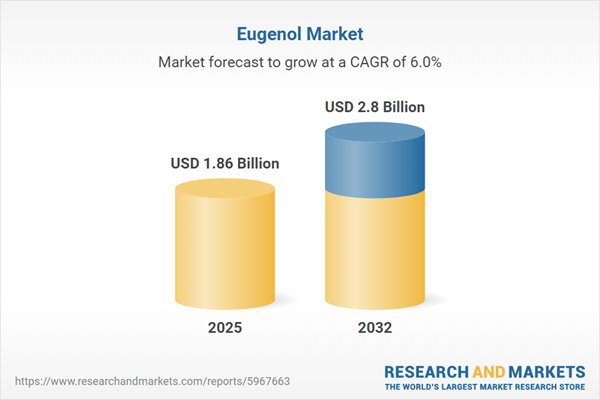Speak directly to the analyst to clarify any post sales queries you may have.
The eugenol market is undergoing transformation as organizations prioritize sustainability, regulatory compliance, and advanced procurement strategies to maintain competitive advantage and operational resilience. Senior leaders face heightened expectations for adaptability, innovation, and risk management across the eugenol value chain.
Market Snapshot: Trends and Drivers in the Eugenol Market
The global eugenol market continues its upward trajectory, propelled by consistent compound annual growth rates and a notable market valuation. Expansion in applications across fragrances, flavors, personal care, and healthcare is shaping new industry standards. Business investments are recalibrated to benefit from the material’s versatility, while procurement specialists focus on sustainable sourcing, advanced traceability, and transparent value chains to meet compliance and improve resilience. Regulatory evolution requires robust supply networks and real-time market intelligence to ensure ongoing adaptability. This dynamic atmosphere encourages innovation as companies respond to both regional and global market shifts.
Scope & Segmentation: Strategic Focus Areas
- Application Areas: Eugenol’s multifaceted role spans agrochemical pesticides, dental analgesics, food flavorings, perfumery, cosmetics, and pharmaceuticals, enabling targeted responses to evolving consumer health and lifestyle trends.
- Source Options: Companies can choose natural sources, such as clove and cinnamon bark, or opt for synthetic production. This dual sourcing supports robust supply chains and flexible procurement amid changing market conditions.
- Product Grades: Availability in food, industrial, and pharmaceutical grades ensures compliance with sector-specific standards and supports customized solutions for each vertical.
- Product Forms: Both liquid and powder forms offer process efficiency for manufacturers, optimizing workflows across diverse production environments.
- Distribution Channels: Direct supplier connections, distributor partnerships, and fully integrated digital sales platforms provide agile, scalable approaches for navigating market volatility.
- Regional Coverage: Broad operations across the Americas, Europe, Asia-Pacific, and Middle East & Africa expose organizations to different regulatory frameworks and consumption patterns, driving the need for local adaptation and procurement flexibility.
- Company Analysis: Major players—including Givaudan SA, Firmenich International SA, Symrise AG, Kerry Group plc, Mane SA, Robertet Group, T. Hasegawa Co., Ltd., Kalsec, Inc., Thermo Fisher Scientific Inc., and International Flavors & Fragrances Inc.—demonstrate strength in scaling supply networks and executing strategic innovations.
- Technology Integration: The sector invests in green extraction, real-time analytics, and digital traceability tools to bolster quality, compliance, and risk management from production to distribution.
Eugenol Market: Key Takeaways for Senior Decision-Makers
- Pursue sustainable procurement and comprehensive traceability to address risks in increasingly complex supply chains.
- Engage collaboratively with suppliers, regulatory bodies, and research organizations to promote continuous innovation and proactively respond to evolving industry standards.
- Direct investments toward advanced manufacturing and digital monitoring solutions to enhance operational adaptability in changing regulatory and market conditions.
- Align market entry and expansion strategies with diverse regional requirements and consumer expectations, achieving compliance and maximizing product acceptance.
- Secure reliable access to quality raw materials through strategic partnerships, supporting supply continuity in variable sourcing environments.
- Employ a diversified procurement strategy incorporating direct suppliers, distributors, and digital channels to swiftly adapt to demand changes and protect supply stability.
Tariff Impact: Navigating Trade and Procurement Changes
Anticipated U.S. tariff reforms in 2025 drive companies to reassess sourcing for key essential oil inputs. Organizations respond by expanding supplier networks, renegotiating procurement agreements, and utilizing advanced financial mechanisms. Continuous risk evaluation and agile procurement approaches are essential to sustain business continuity as new trade regulations come into play.
Methodology & Data Sources
This analysis is informed by executive interviews, interdisciplinary roundtable input, extensive regulatory review, and a broad literature base. Advanced analytics and scenario modeling support actionable recommendations geared towards senior decision-makers.
Why This Report Matters
- Granular segmentation guides procurement, operations, and technology leaders in optimizing supplier selection and enhancing supply chain resilience.
- Proactive risk assessment strategies enable organizations to respond flexibly to dynamic market conditions, supporting operational stability.
- Strategic guidance facilitates progress toward sustainability and process excellence throughout the eugenol supply chain.
Conclusion
Adapting to the shifting eugenol landscape requires strategic foresight and organizational agility. This report equips senior leaders with evidence-based insights for sustaining competitive positioning and operational resilience as the industry evolves.
Additional Product Information:
- Purchase of this report includes 1 year online access with quarterly updates.
- This report can be updated on request. Please contact our Customer Experience team using the Ask a Question widget on our website.
Table of Contents
3. Executive Summary
4. Market Overview
7. Cumulative Impact of Artificial Intelligence 2025
Companies Mentioned
The companies profiled in this Eugenol market report include:- Givaudan SA
- International Flavors & Fragrances Inc.
- Firmenich International SA
- Symrise AG
- Kerry Group plc
- Mane SA
- Robertet Group
- T. Hasegawa Co., Ltd.
- Kalsec, Inc.
- Thermo Fisher Scientific Inc.
Table Information
| Report Attribute | Details |
|---|---|
| No. of Pages | 195 |
| Published | October 2025 |
| Forecast Period | 2025 - 2032 |
| Estimated Market Value ( USD | $ 1.86 Billion |
| Forecasted Market Value ( USD | $ 2.8 Billion |
| Compound Annual Growth Rate | 5.9% |
| Regions Covered | Global |
| No. of Companies Mentioned | 11 |









